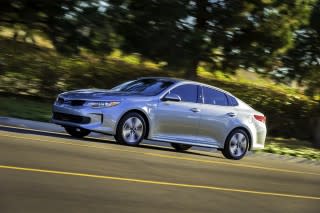2017 Kia Optima Hybrids: Details On 27-Mile Plug-In Hybrid, Live Photos And Video
Kia aims for a 25-percent increase in its U.S. fleet-wide fuel efficiency by 2020; and the new 2017 Optima Hybrid and Optima Plug-In Hybrid (PHEV), introduced today at the Chicago Auto Show and due later this year, are key additions to the brand’s lineup to achieve that.
Although the new Optima Hybrid and Optima PHEV are new models, they’re not mechanically unique. They have the same 27-mile all-electric EPA rating, the same 154-horsepower, 2.0-liter four-cylinder engine, the same six-speed automatic transmission packaged with a 38-kW (or 50-kW for the PHEV) single electric motor, and the same 1.62-kWh (or 9.8-kWh) lithium-ion battery pack, as the Hyundai Sonata Plug-In Hybrid.
Multiple modes—including a charge-restoring one
Compared to the Sonata Plug-In Hybrid, the Optima Plug-In Hybrid offers the same choice between an all-electric mode, a hybrid mode that saves electric charge, and a charging mode, which charges the battery pack—at some expense of fuel economy and tailpipe emissions, of course.
What’s different, of course, is the rest of the package. These new hybrid and plug-in hybrid models are both indistinguishable from the mainstream Optima sedans in some respects—although they get active grille shutters plus a series of aerodynamic improvements that lower the coefficient of drag to a phenomenal 0.24.
ALSO SEE: 2017 Kia Niro Hybrid Crossover Utility Vehicle Debuts At Chicago Auto Show

That should be a good thing, as we’ve found the latest 2016 Kia Optima sedans to be far more comfortable and refined than their predecessors. Their supremely quiet ride, well-balanced ride-and-handling traits, and warmer, finely detailed interiors make the Optima lineup one of the best entries in its class.
And based on our first drive experience, and follow-ups, with the Hyundai Sonata Hybrid and Plug-In Hybrid, these models benefit from tremendous improvement in the hybrid system’s electronic controls that allow it to accelerate far more smoothly yet have heightened responses.

 Yahoo Autos
Yahoo Autos 
